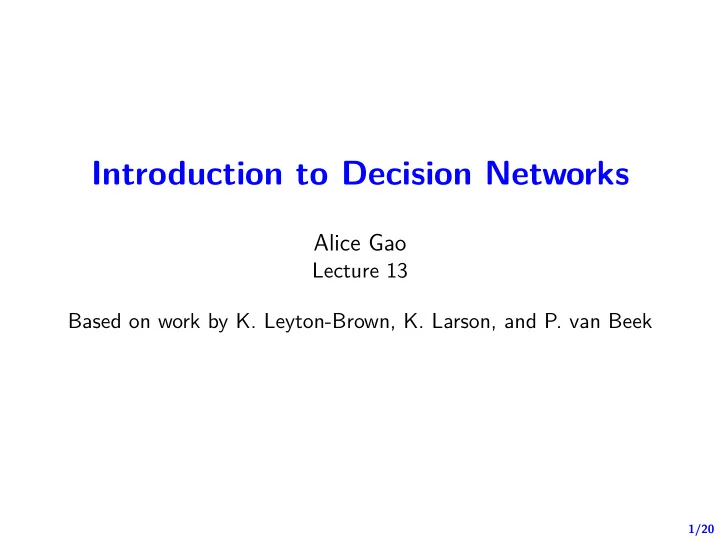

1/20 Introduction to Decision Networks Alice Gao Lecture 13 Based on work by K. Leyton-Brown, K. Larson, and P. van Beek
2/20 Outline Learning Goals Introduction to Decision Theory Decision Network for Mail Delivery Robot Evaluating the Robot Decision Network Revisiting the Learning goals
3/20 Learning Goals By the end of the lecture, you should be able to network containing nodes, arcs, conditional probability distributions, and a utility function. ▶ Model a one-ofg decision problem by constructing a decision ▶ Choose the best action by evaluating a decision network.
4/20 Decision Theory Decision theory = Probability theory + Utility theory the basis of the evidence ▶ Decision theory: describes what an agent should do ▶ Probability theory: describes what an agent should believe on ▶ Utility theory: describes what an agent wants
5/20 Decision Networks Decision networks = Bayesian network + actions + utilities
6/20 A robot that delivers mail The robot must choose its route to pickup the mail. There is a short route and a long route. The long route is slower, but on the short route the robot might slip and fall. The robot can put on pads. This won’t change the probability of an accident, but it will make it less severe if it happens. Unfortunately, the pads add weight and slow the robot down. The robot would like to pick up the mail quickly with little/no damage. What should the robot do?
7/20 Variables What are the random variables? What are the decision variables (actions)?
8/20 Nodes in a Decision Network Three kinds of nodes: Chance nodes represent random variables (as in Bayesian networks). Utility node represents agent’s utility function on states (happiness in each state). ▶ ▶ Decision nodes represent actions (decision variables). ▶
9/20 Robot decision network
10/20 Arcs in the Decision Network How do the random variables and the decision variables relate to one another?
11/20 Robot decision network
12/20 mail. There is a short route and a long route. The robot would like to pick up the mail pads add weight and slow the robot down. less severe if it happens. Unfortunately, the probability of an accident, but it will make it can put on pads. This won’t change the route the robot might slip and fall. The robot The long route is slower, but on the short The robot must choose its route to pickup the CQ: The robot’s happiness and (C) (E) All of (A), (B) (B), and (C) (D) Two of (A), (C) A only (B) S only (A) P only CQ: Which variables directly infmuence the robot’s happiness? quickly with little/no damage.
13/20 Robot decision network
14/20 CQ The robot’s utility function true? (A) The robot prefers not wearing pads than wearing pads. (B) The robot prefers the long route over the short route. (C) Both (A) and (B) are true. (D) Neither (A) and (B) is true. CQ: When an accident does not happen, which of the following is
15/20 10 8 4 0 The robot’s utility function 2 State 6 U ( w i ) ¬ P , ¬ S , ¬ A w 0 slow, no weight ¬ P , ¬ S , A w 1 impossible ¬ P , S , ¬ A w 2 quick, no weight ¬ P , S , A w 3 severe damage P , ¬ S , ¬ A w 4 slow, extra weight P , ¬ S , A w 5 impossible P , S , ¬ A w 6 quick, extra weight P , S , A w 7 moderate damage
16/20 The robot’s utility function How does the robot’s utility/happiness depend on the random variables and the decision variables?
17/20 The robot’s utility function How does the robot’s utility/happiness depend on the random variables and the decision variables?
18/20 Robot decision network
19/20 Evaluating a decision network How do we choose an action? 1. Set evidence variables for current state 2. For each possible value of decision node (a) set decision node to that value (b) calculate posterior probability for parent nodes of the utility node (c) calculate expected utility for the action 3. Return action with highest expected utility
20/20 Revisiting the Learning Goals By the end of the lecture, you should be able to network containing nodes, arcs, conditional probability distributions, and a utility function. ▶ Model a one-ofg decision problem by constructing a decision ▶ Choose the best action by evaluating a decision network.
Recommend
More recommend